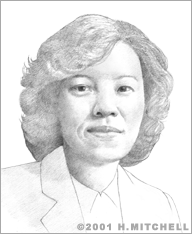Anne Chiang
Anne Chiang is responsible for numerous accomplishments in electronic display devices and other computing technologies. Her research and development work on flat panel displays, semiconductor devices, and optical/magnetic recording has been applied industry-wide. Chiang is perhaps best-known, however, for her work on low temperature, glass-compatible, high-speed polysilicon coatings for large area electronics, otherwise known as thin-film transistor technology, or TFT.
Chiang was born and raised in Taiwan. As a child, she possessed a keen curiosity and intelligence that led to her graduation with top honors from the Taipei First Girls’ School and acceptance into National Taiwan University with an exemption from taking entrance examinations. She earned a BS from National Taiwan University in 1964, specializing in electrochemistry. From there, Chiang emigrated to the United States where she eventually earned a PhD in physical chemistry from the University of Southern California (USC).
Following her graduation from USC in 1968, Chiang joined Memorex as a project manager, where she invented an organic photoconductor-based microfilm for computer data recording. She also produced magnetic tape and disk coating formulations with improved dispersion of magnetic particles.
In 1971, Chiang accepted a position with the Xerox Parc Palo Alto Research Center (PARC), and it wasn’t long before she had gained a reputation in her industry for her work on the electrophoretic displays. She invented several novel display devices there, including a stylus-writable electrophoretic display, a phototransistor, and a new material for a low-cost electrophoretic display.
Chiang began working on TFT technology in the 1980s. Leading a team of researchers at Xerox PARC, Chiang worked from 1987 to 1994 on materials, processes, and application aspects of low temperature, polysilicon TFT technology, generating numerous patents and publications in the field. Eventually, she and her team developed a process enabling the fabrication of flat panel displays with pixel contents well beyond millions of pixels.
Chiang’s approach, called “System on the Panel,” uses the display substrate not only for the display itself but also for integrating all the electronic components of a computing system, such as memory, microprocessor, and input devices. Today’s light weight, radiation-free, space- and energy-efficient, portable flat panel display personal computers are a direct result of her work, which also helps to enable the development of today’s high performance, pocket-sized, portable communication systems.
Chiang’s technology could also help to revolutionize the field of medical diagnostic radiography. Currently, radiologists use film to view x-ray images, but the resolution is limited. Digital radiography using flat-panel displays could help to improve resolution and thus, contribute to early detection.
Chiang was a product engineering manager working for a Xerox company in Palo Alto, California, formed out of the former Electronics and Imaging Laboratory of Xerox PARC. Today, she is principal of Chiang Consulting, a privately owned company that she formed in Cupertino, California.


